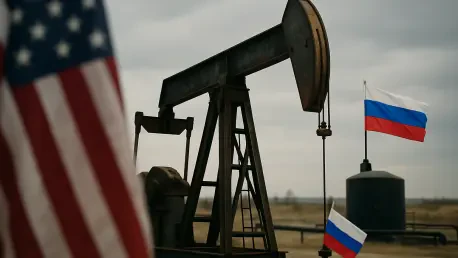In a world where energy fuels not just economies but also wars, a seismic shift has unfolded on the global stage with the United States taking decisive action. On October 22, the United States unleashed a powerful blow against Russia’s economic engine, targeting Rosneft and Lukoil—two titans of the oil industry—with Ukraine-related sanctions. This bold maneuver, under President Donald Trump’s second term, isn’t just a policy update; it’s a direct strike at the financial arteries sustaining Russia’s military actions in Ukraine. What does this mean for global energy markets, international alliances, and the ongoing conflict? The stakes couldn’t be higher as this decision ripples across continents.
A Defining Moment in Geopolitical Strategy
The significance of these sanctions cannot be overstated. With Russia’s invasion of Ukraine stretching into its third year since 2022, oil revenues have remained a critical lifeline for the Kremlin’s war efforts. Rosneft and Lukoil, which together account for a substantial share of Russia’s energy exports, are now under intense pressure as the U.S. seeks to choke off funds fueling military operations. This isn’t merely a symbolic gesture; it’s a calculated effort to force a turning point in a conflict that has reshaped global security and trade dynamics, impacting everything from gas prices to diplomatic relations.
Beyond the immediate target, this move signals a broader shift in U.S. foreign policy. Unlike previous reliance on trade measures, the direct sanctions reflect growing frustration with Vladimir Putin’s unyielding stance. For American citizens, the implications extend to potential fluctuations at the pump and the nation’s role in maintaining international stability. As the Treasury Department, led by Secretary Scott Bessent, drives this initiative, the question looms: can economic pressure achieve what diplomacy has struggled to deliver?
The Mechanics of Economic Warfare
Delving into the strategy, the U.S. approach is both intricate and ambitious. The sanctions aim to slash the oil revenues that reportedly contribute over 40% of Russia’s federal budget, a lifeline for military spending. By targeting Rosneft and Lukoil, the Treasury Department seeks to disrupt billions in annual income, with estimates suggesting these companies generate upwards of $100 billion combined in export earnings. Additionally, a $60 price cap on Russian oil, previously imposed by Western nations, has already redirected trade flows from Europe to Asia, a trend these sanctions intend to further constrain.
International coordination forms another pillar of this plan. The U.S. has urged allies to enforce parallel measures, following Britain’s recent sanctions on the same companies. Yet, complexities arise with Trump’s additional 25% tariff on Indian goods as retaliation for purchasing discounted Russian oil, while China faces no such penalty. This selective enforcement raises eyebrows about consistency and the potential for diplomatic friction among key trade partners, complicating the global united front against Russia.
Voices from the Frontlines of Policy and Conflict
Reactions to the sanctions reveal a spectrum of hope and doubt among stakeholders. Edward Fishman, a former U.S. official with expertise in economic statecraft, cautioned that without secondary sanctions on entities engaging with Rosneft and Lukoil, the impact might be fleeting. “This risks being a one-and-done measure if loopholes aren’t closed,” he noted, emphasizing the need for broader enforcement to truly isolate Russia’s oil sector. Similarly, Jeremy Paner, a former Treasury sanctions investigator, highlighted the exclusion of major buyers like India and China as a potential weak link in the strategy.
Contrastingly, a senior Ukrainian official expressed enthusiasm, describing the sanctions as “a long-overdue step” that Kyiv has advocated for years. This sentiment underscores the desperation for tangible action against Russia’s war funding. Meanwhile, Trump himself voiced a nuanced perspective, hoping the measures remain temporary to avoid jeopardizing the U.S. dollar’s dominance in global oil trade, especially as Russia pushes for transactions in alternative currencies. These diverse viewpoints paint a picture of cautious optimism mixed with pragmatic concern over execution.
Global Ripples and Unintended Consequences
The fallout from these sanctions extends far beyond Russia’s borders, reshaping energy markets and geopolitical alignments. With Europe largely pivoting away from Russian oil due to prior restrictions, Asia—particularly India and China—has absorbed much of the redirected supply at discounted rates. This shift, while benefiting some economies, poses challenges for the U.S. strategy, as sanctioned oil could still find buyers through less-regulated channels. The Treasury Department must now monitor these trade patterns closely to prevent Russia from circumventing the economic squeeze.
Domestic implications for the U.S. also warrant attention. As energy prices remain a sensitive issue for American consumers, any disruption in global oil supply chains could translate to higher costs at home. Furthermore, Trump’s decision to cancel a planned summit with Putin in Hungary, citing inappropriate timing amid escalating tensions, signals a reluctance to engage diplomatically while sanctions unfold. This delicate balance between economic warfare and political signaling adds another layer of complexity to an already fraught situation.
Charting the Path Forward with Strategic Precision
Looking ahead, the effectiveness of these sanctions hinges on sustained and adaptable action. Policymakers should prioritize secondary sanctions on foreign entities dealing with Rosneft and Lukoil to tighten the economic noose around Russia. Encouraging wider participation from allies beyond the U.S. and Britain remains critical to prevent Russia from simply redirecting trade to non-sanctioned markets. Tracking shifts in global oil flows, especially in Asia, will also be essential to refine measures like price caps and tariffs over time.
Reflecting on the road taken, the U.S. stance evolved from trade-focused measures to direct sanctions, marking a pivotal escalation in response to the Ukraine conflict. Yet, the selective targeting of trade partners and the absence of broader financial penalties revealed gaps that tempered the impact on Moscow. Despite this, the coordinated Western push and Ukraine’s endorsement highlighted a shared resolve to confront Russia’s actions. Moving forward, balancing geopolitical pressure with economic stability emerged as the defining challenge, with the Treasury’s call for allied unity offering a potential blueprint for success in the years that followed.









